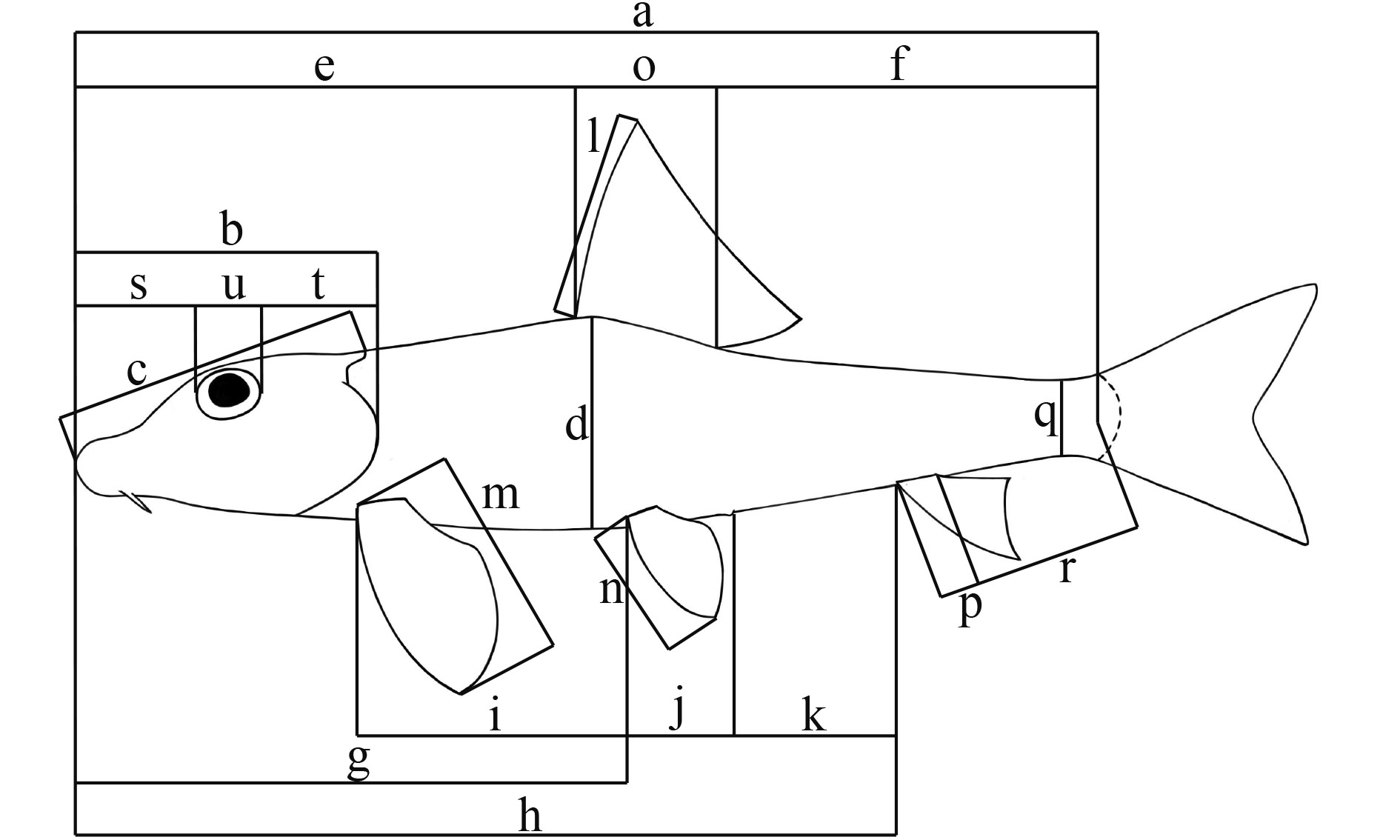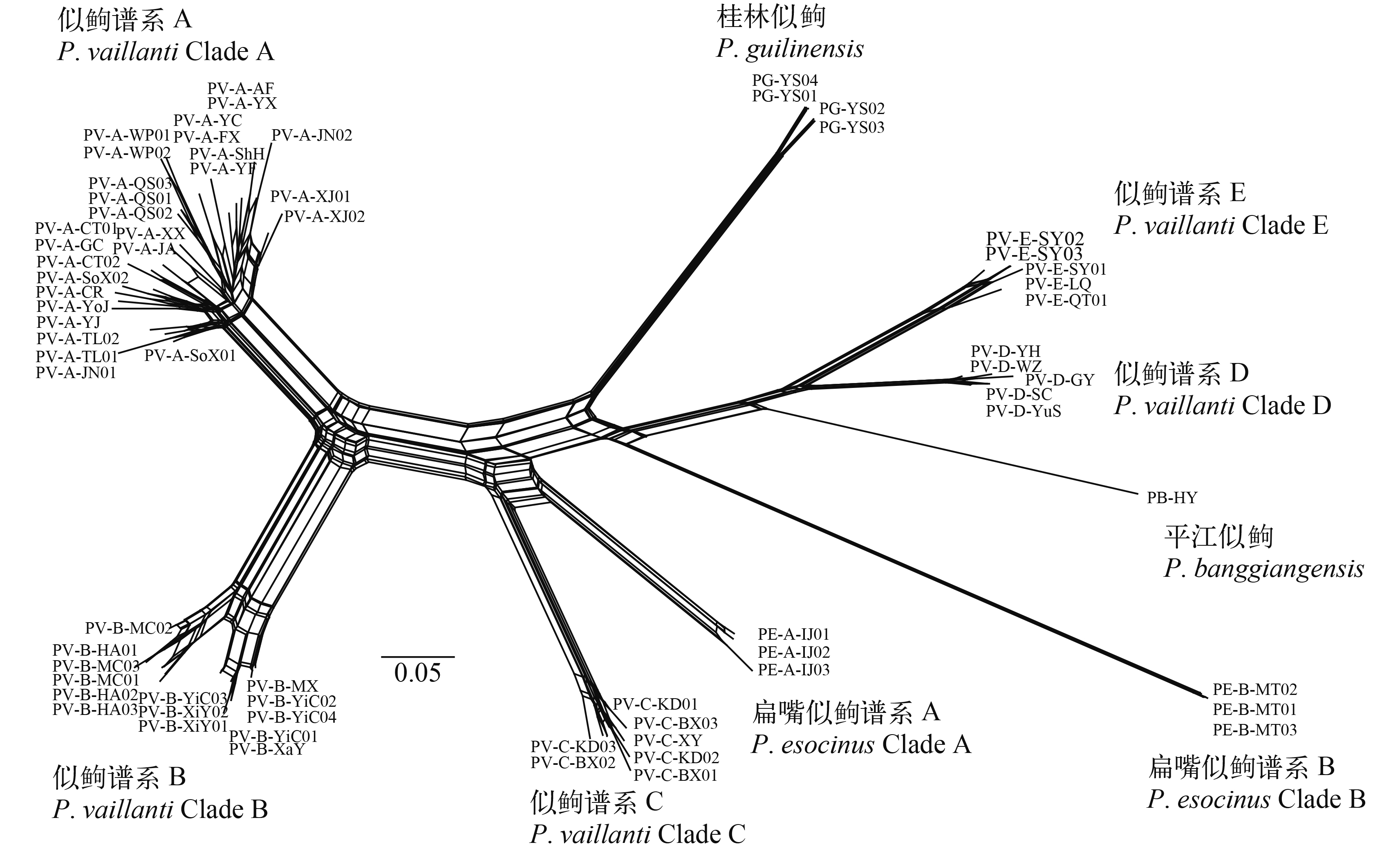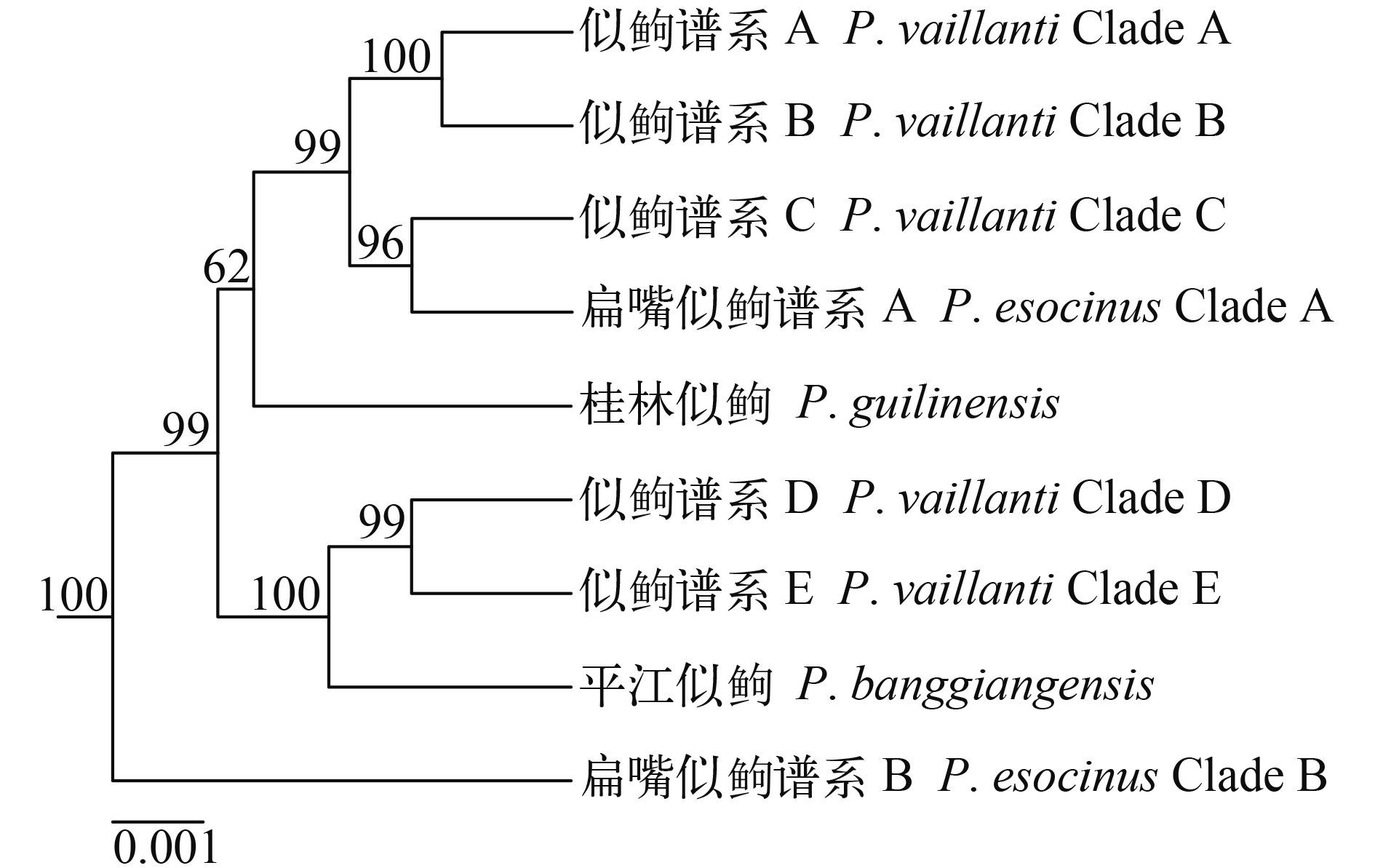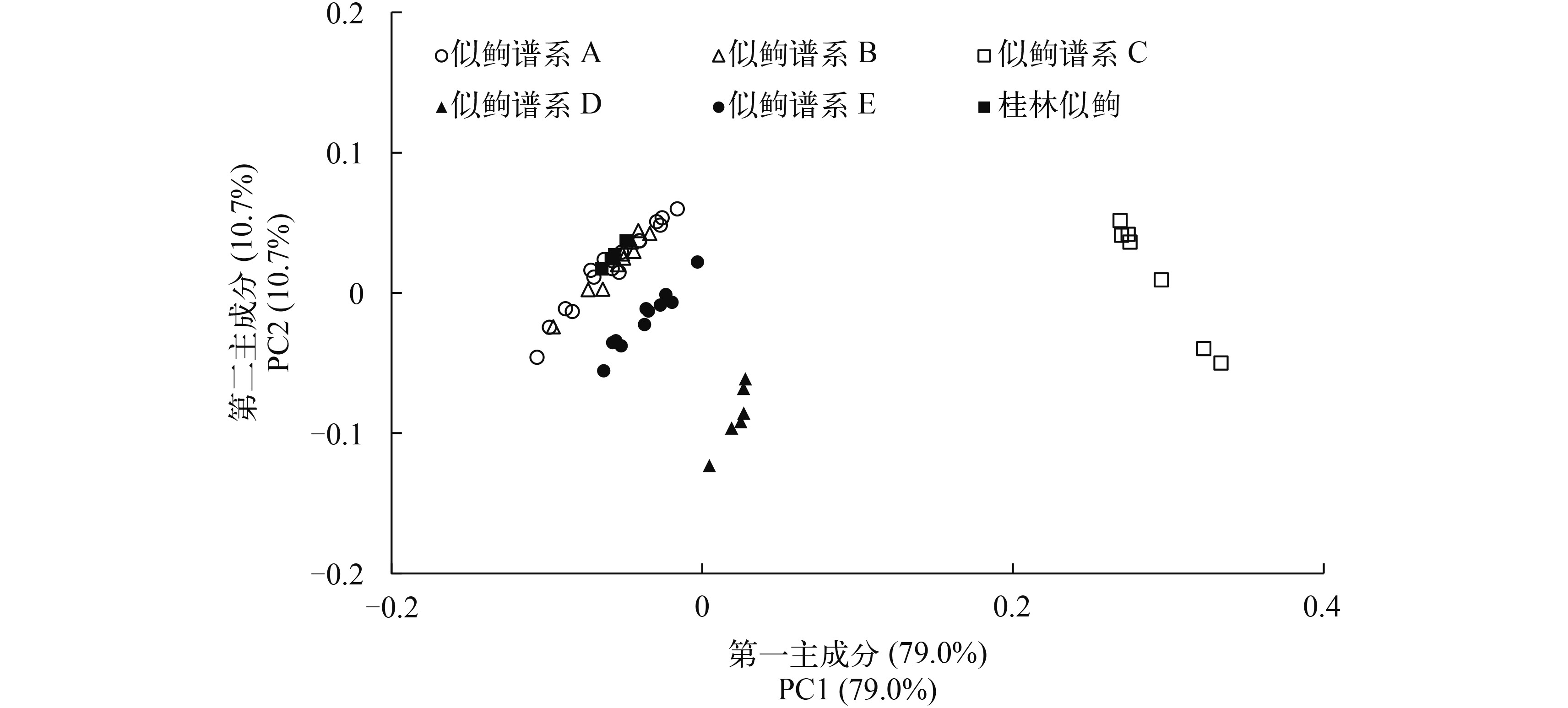SPECIES DELIMITATION AND PHYLOGENETIC RELATIONSHIPS OFPSEUDOGOBIO FISHES IN THE SUBFAMILY GOBIONINAE
-
摘要: 逗亚科似逗属鱼类的物种界定保持争议, 系统发育关系尚待解决。研究取样似逗属鱼类所有种, 使用核基因多位点序列重建似逗属鱼类的系统发育关系, 运用分子的物种界定方法并结合形态特征分析厘定我国似逗属鱼类的分类。贝叶斯系统发育树结果表明: 桂林似逗与平江似逗是单系种; 似逗与扁嘴似逗是多系种, 前者包括五个谱系A至E, 后者包括两个谱系A与B。POFAD距离分析和Structurama分析的结果表明似逗和扁嘴似逗的每个谱系是独立遗传种群, BP & P分析结果强烈支持它们是不同种。*Beast物种树结果揭示: 扁嘴似逗谱系B位于似逗属鱼类的基部位置; 似逗谱系A与B是姊妹群关系, 似逗谱系C是扁嘴似逗谱系A的姊妹群, 它们一起与桂林似逗形成姊妹群关系; 似逗谱系D与E是姊妹群关系, 它们一起是平江似逗的姊妹群。结合形态证据, 对我国似逗属鱼类分类厘定如下: 限定严格意义似逗包括似逗谱系A+B; 恢复长吻似逗(Pseudogobio longirostris Mori, 1934)给予似逗谱系C分类名; 似逗谱系D与E是隐存种, 桂林似逗与平江似逗是有效种。Abstract: Species delimitation and phylogenetic relationships of the genus Pseudogobio fishes in the subfamily Gobio-ninae remain debated and unresolved. This study used molecular species delimitation methods and morphological analyses to reconstruct phylogenetic relationships of Pseudogobio fishes based on nuclear loci and the classification of this genus in China. The results of Bayesian tree showed that Pseudogobio guilinensis and P. banggiangensis were monophyletic specie, and that P. vaillanti and P. escocinus were polyphyletic species that the former included five Clades A-E and the latter was comprised of two Clades A and B. The analyses of POFAD and Structurama showed that each clade of P. vaillanti and P. escocinus were independent genetic populations, and BP & P analysis strongly supported them as different species. The results of *Beast species tree revealed that P. esocinus Clade B occupied a basal position of Pseudogobio fishes; Clades A and B of P. vaillanti were the sister taxon relationship, and P. vaillanti Clade C was the sister taxon of P. esocinus Clade A, and all of them together were the sister group of P. guilinensis; Clades D and E of P. vaillanti were the sister taxon relationship, which were the sister group of P. banggiangensis. A revised classification of Pseudogobio fishes in China by molecular and morphological evidence as follows: P. vaillanti sensu stricto was limited to P. vaillanti Clades A and B; A resurrection of P. longirostris Mori, 1934 was assigned to P. vaillanti Clade C; Clades D and E of P. vaillanti were cryptic species, and P. guilinensis and P. banggiangensis were valid species, respectively.
-
Keywords:
- Cyprinidae /
- Gobioninae /
- Pseudogobio /
- Species delimitation /
- Phylogeny
-
-
图 1 可量性状示意图(参考Kottelat & Jorg[38])
a. 体长; b. 头长; c. 背侧头长; d. 体高; e. 背鳍前长; f. 背鳍后长; g. 腹鳍前长; h. 臀鳍前长; i. 胸腹鳍起点间距离; j. 腹鳍肛门起点间距离; k. 肛门臀鳍起点间距离; l. 背鳍长; m. 胸鳍长; n. 腹鳍长; o. 背鳍基长; p. 臀鳍基长; q. 尾柄高; r. 尾柄长; s. 吻长; t. 眼后头长; u. 眼径; v. 眼间距(图中未显示)
Figure 1. The diagram of morphometric characters (referring to Kottelat & Jorg[38])
a. Standard length (SL); b. Head length (HL); c. Dorsal head length; d. Body depth; e. Pre-dorsal length; f. Post-dorsal length; g. Pre-pelvic length; h. Pre-anal length; i. Distance between pectoral- and pelvic-fin origins; j. Distance between pelvic-fin and anus origins; k. Distance between anus and anal-fin origins; l. Length of dorsal fin; m. Length of pectoral fin; n. Length of pelvic fin; o. Length of dorsal-fin base; p. Length of anal-fin base; q. Depth of caudal peduncle; r. Length of caudal peduncle; s. Snout length; t. Postorbital length; u. Eye diameter; v. Eye diameter (not shown in this figure)
表 1 种名、采样地点、个体编号及GenBank登录号
Table 1 Species, sampling sites, code and GenBank accession number of all individuals
采样地点Sampling locality 编号Code GenBank登录号GenBank accession number MLH3 MSH6 ENC1 RAG1 rpS7 Intron 1 广义似逗Pseudogobio vaillanti sensu lato 安徽省潜山县 (长江下游) PV-A-QS01 KX078872 KX078974 KX079148 KX078923 KX079002 安徽省潜山县 (长江下游) PV-A-QS02 KX079298 KX079221 KX079147 KX079062 KX078990 安徽省潜山县 (长江下游) PV-A-QS03 KX079297 KX079226 KX079146 KX079063 KX079000 江西省靖安县 (长江下游) PV-A-YC KX079313 KX079222 KX079152 KX079071 KX078991 江西省奉新县 (长江下游) PV-A-FX KX079312 KX079225 KX079167 KX079053 KX078992 江西省余江县 (长江下游) PV-A-YJ KX079295 KX079219 KX079150 KX079072 KX078999 江西省安福县 (长江下游) PV-A-AF KX079303 KX079212 KX079171 KX079049 KX079013 江西省新余市 (长江下游) PV-A-XX KU715610* KX079217 KX079145 KX079074 KX079005 江西省永丰县 (长江下游) PV-A-YF KX079296 KX079224 KX079151 KX079059 KX079006 江西省永新县 (长江下游) PV-A-YX KX079294 KX079223 KX079149 KX079073 KX079001 江西省遂川县 (长江下游) PV-A-JA KX079301 KX079220 KX079165 KX079055 KX079004 江西省崇仁县 (长江下游) PV-A-CR KX079302 KX079207 KX079170 KX079050 KX079007 江西省广昌县 (长江下游) PV-A-GC KX079311 KX079206 KX079166 KX079054 KX078993 浙江省桐庐县 (钱塘江) PV-A-TL01 KX079310 KX079210 KX079159 KX079064 KX078989 浙江省桐庐县 (钱塘江) PV-A-TL02 KX079292 KX079211 KX079158 KX079065 KX078987 浙江省永嘉县 (瓯江) PV-A-YoJ KX079304 KX079214 KX079155 KX079068 KX078998 浙江省仙居县 (灵江) PV-A-XJ01 KX079299 KX079208 KX079154 KX079069 KX079011 浙江省仙居县 (灵江) PV-A-XJ02 KX079309 KX079213 KX079153 KX079070 KX079012 福建省松溪县 (闽江) PV-A-SoX01 KX079291 KX079205 KX079161 KX079060 KX079008 福建省松溪县 (闽江) PV-A-SoX02 KX079293 KX079218 KX079160 KX079061 KX078994 福建省建宁县 (闽江) PV-A-JN01 KX079306 KX079209 KX079164 KX079056 KX078988 福建省建宁县 (闽江) PV-A-JN02 KX079300 KX079216 KX079163 KX079057 KX078997 福建省长汀县 (韩江) PV-A-CT01 KX079308 KX079230 KX079169 KX079051 KX079009 福建省长汀县 (韩江) PV-A-CT02 KX079307 KX079229 KX079168 KX079052 KX079010 福建省上杭县 (韩江) PV-A-ShH KX079305 KX079215 KX079162 KX079058 KX079003 福建省武平县 (韩江) PV-A-WP01 KX079290 KX079228 KX079157 KX079066 KX078995 福建省武平县 (韩江) PV-A-WP02 KX079289 KX079227 KX079156 KX079067 KX078996 陕西省勉县 (长江中游) PV-B-MX KX079271 KX079202 KX079122 KX079092 KX079023 河南省新野县 (长江中游) PV-B-XiY01 KX079270 KX079195 KX079123 KX079099 KX079025 河南省新野县 (长江中游) PV-B-XiY02 KX079273 KX079197 KX079124 KX079090 KX079026 表 2 分子标记扩增使用的引物
Table 2 Primers for the amplification of molecular markers
基因Gene 正向引物Forward primer (5′-3′) 反向引物Reverse primer (5′-3′) 来源Source ENC1 AGGCCGGTGACATGCTGGA GGAGGTGYTTCCAGGTGCTGA 本研究 MLH3 TAGACATAGAAGCCTGCAA TGGTTCRAGGCATATGTCAT 本研究 CGTGAGGGYCATTACAA CCGCCATGTTRGTGACATC MSH6 CAGACAGCCCTGTRAAAC GAGTACCCATGCTRTGGAT 本研究 AACCTTGAGATCCTTCAGAA GAAGAGTCTCCTCATGCAGTC RAG1 CAGTAYCAYAAGATGTACCG TTGTGAGCYTCCATRAACTT Kim & Bang[23] rpS7 intron 1 GCCTCTTCCCAGGCCGTC AACTCATCTGGCTTTTCGCC Chow & Hazama[24] 表 3 似鳇谱系A至E、桂林似鳇和平江似鳇的形态特征
Table 3 Morphological characters of Pseudogobio vaillanti Clades A-E, Pseudogobio guilinensis and Pseudogobio banggiangensis
可数性状与可量性状Morphometrics and Meristics 似逗谱系AP. vaillanti Clade A (n=12) 似逗谱系BP. vaillanti Clade B (n=10) 似逗谱系CP. vaillanti Clade C (n=7) 似逗谱系DP. vaillanti Clade D (n=5) 似逗谱系EP. vaillanti Clade E (n=5) 桂林似逗P. guilinensis (n=4) 平江似逗P. banggiangensis (n=1) 背鳍Dorsal fin iii-7 (12) iii-7 (10) iii-7 (7) iii-7 (5) iii-7 (5) iii-7 (4) iii-7 胸鳍Pectoral fin i-13 (3), i-14 (9) i-13 (4), i-14 (6) i-12 (1), i-13 (6) i-14 (4), i-15 (1) i-14 (5) i-14 (4) i-15 腹鳍Pelvic fin i-7 (12) i-7 (10) i-6 (1), i-7 (6) i-7 (5) i-7 (5) i-7 (4) i-8 臀鳍Anal fin iii-6 (12) iii-6 (10) iii-6 (7) iii-6 (5) iii-6 (5) iii-6 (4) iii-6 侧线鳞Lateral-line scales 40 (7), 41 (5) 40 (9), 41 (1) 41 (3), 42 (4) 41 (3), 42 (2) 40 (1), 41 (4) 43 (4) 41 侧线上鳞Scales between lateral line and dorsal-fin origin 5 (7), 6 (5) 6 (10) 6 (7) 6 (5) 6 (5) 6 (4) 6 至腹鳍侧线下鳞Scales between lateral line and pelvic-fin origin 3 (12) 3 (10) 3 (7) 3 (5) 3 (5) 3 (4) 3 至臀鳍侧线下鳞Scales between lateral line and anal-fin origin 4 (12) 4 (10) 4 (7) 4 (5) 4 (5) 4 (4) 4 背鳍前鳞Pre-dorsal scales 10 (2), 11 (8), 12 (2) 11 (7), 12 (3) 12 (5), 13 (2) 11 (2), 12 (3) 11 (2), 12 (3) 12 (4) 15 围尾柄鳞Circumpeduncular scales 12 (12) 12 (10) 12 (7) 12 (5) 12 (5) 12 (4) 12 体长Standard length (mm) 92.7—117.9 90.8—136.7 94.83—114.94 97.2—139.7 96.0—119.5 86.4—120.7 113.13 体长的百分比(%) 头长Head length 24.2—29.2 25.8—31.0 25.2—29.3 27.1—28.4 24.9—28.5 26.6—30.1 28.1 背侧头长Dorsal head length 22.1—25.9 23.3—26.8 22.7—26.6 24.1—26.4 22.4—26.1 24.2—27.8 24.6 体高Body depth 16.0—21.4 17.5—21.0 16.0—19.3 17.9—19.6 17.1—20.4 16.2—22.0 19.3 背鳍前长Pre-dorsal length 41.4—46.8 42.7—46.4 43.2—47.3 44.6—47.2 42.7—46.2 44.4—48.2 47.9 背鳍后长Post-dorsal length 39.7—46.1 41.0—45.1 40.2—44.9 40.1—42.9 40.7—43.9 38.9—43.1 37.5 腹鳍前长Pre-pelvic length 46.7—53.6 47.5—52.6 47.3—50.6 47.2—50.3 46.3—48.6 48.6—52.7 51.0 臀鳍前长Pre-anal length 76.2—82.6 77.5—82.1 79.0—83.9 76.6—82.8 76.6—79.5 78.1—82.3 83.0 胸腹鳍起点间距离Distance between pectoral- and pelvic-fin origins 21.1—27.2 20.4—24.3 20.9—24.7 21.5—25 19.5—23.0 21.7—25.1 24.4 腹鳍肛门起点间距离Distance between pelvic-fin and anus origins 5.9—7.4 6.4—8.3 7.0—8.2 5.6—7.4 6.5—7.6 6.3—6.8 7.3 肛门臀鳍起点间距离Distance between anus and anal-fin origins 18.0—27.0 20.1—25.4 21.1—25.4 22.8—25.4 22.1—24.4 21.2—25.0 24.7 背鳍长Length of dorsal fin 20.0—23.6 19.7—23.1 21.5—22.7 19.8—23.7 19.8—22.6 21.1—22.1 22.1 胸鳍长Length of pectoral fin 19.2—22.8 20.2—23.8 21.4—23.2 21.8—26 20.1—21.1 20.4—24.0 21.6 腹鳍长Length of pelvic fin 15.4—18.5 15.2—18.7 16.5—18.4 16.3—20 16.2—17.9 17.2—18.1 18.0 背鳍基长Length of dorsal-fin base 11.5—13.5 11.8—13.7 11.4—13.1 11.5—12.7 12.3—13.9 12.0—13.2 14.5 臀鳍基长Length of anal-fin base 6.5—8.6 6.0—7.1 6.2—7.0 6.1—7.2 6.5—7.2 6.2—7.1 6.6 尾柄高Depth of caudal peduncle 6.9—8.3 6.8—7.5 6.9—7.6 6.5—7.2 7.0—7.6 6.4—6.9 7.4 尾柄长Length of caudal peduncle 11.9—16.5 13.6—15.6 12.7—16.4 12.3—14.3 12.7—16.1 14.1—16.2 11.4 头长的百分比(%) 吻长Snout length 40.6—51.9 45.5—50.5 45.7—52.0 48.1—51.2 46.4—49.7 47.2—51.0 43.9 眼后头长Postorbital length 25.5—35.1 26.8—33.7 25.1—30.6 23.1—30.5 27.2—29.4 27.4—30.8 31.8 眼间距Interorbital width 14.7—21.2 18.4—23.1 15.9—18.7 19.0—20.2 18.3—21.6 18.4—20.1 18.6 眼径Eye diameter 20.9—26.2 20.4—23.2 22.0—24.8 21.3—25.7 22.4—25.4 21.2—23.6 24.3 注: 显示可数性状的记数(括号中是个体数)和可量性状的测量范围, 似逗谱系定义依据图 2 Note: The count of meristic characters (individual numbers in bracket) and the range of morphometric characters were shown. Pseudogobio vaillanti Clades defined as inFig. 2 -
[1] Bǎnǎrescu P, Nalbant T T. Pisces, Teleostei, Cyprinidae (Gobioninae) [M]. Das Tierreich, Lieferung 93, Berlin: Walter de Guryter. 1973, 1—304
[2] 乐佩琦. 似逗属. 见: 陈宜瑜, 中国动物志硬骨鱼纲鲤形目(中卷). 北京: 科学出版社. 1998, 374—378 Yue P Q. Pseudogobio Bleeker, 1860 [A]. In: Chen Y Y (Eds.), Fauna Sinica, Osteichthyes, Cypriniformes (II) [C]. Beijing: Science Press. 1998, 374—378
乐佩琦. 似逗属. 见: 陈宜瑜, 中国动物志硬骨鱼纲鲤形目(中卷). 北京: 科学出版社. 1998, 374—378[3] 谢从新, 刘齐德. 似逗生物学的初步研究. 华中农业大学学报, 1986, 5(1): 73—82 http://www.cnki.com.cn/Article/CJFDTOTAL-HZNY198601012.htm Xie C X, Liu Q D. A Preliminary study on the biology of Pseudogobio vaillanti vaillanti (Sauvage) [J]. Journal of Huazhong Agricultural University, 1986, 5(1): 73—82
谢从新, 刘齐德. 似逗生物学的初步研究. 华中农业大学学报, 1986, 5(1): 73—82 http://www.cnki.com.cn/Article/CJFDTOTAL-HZNY198601012.htm[4] Eschmeyer W N, Fricke R, Van der Laan R. Catalog of Fishes: Genera, Species, References, http://researcharchive.calacademy.org/research/ichthyology/catalog/fishcatmain.asp
[5] 罗云林, 乐佩琦, 陈宜瑜. 似逗属. 见: 伍献文, 中国鲤科鱼类志(下卷). 上海: 上海人民出版社. 1977, 512—516 Luo Y L, Yue P Q, Chen Y Y. Pseudogobio Bleeker, 1860 [A]. In: Wu X W (Eds.), Fauna of Cyprinidae in China (II) [C]. Shanghai: Shanghai People’s Publishing House. 1977, 512—516
罗云林, 乐佩琦, 陈宜瑜. 似逗属. 见: 伍献文, 中国鲤科鱼类志(下卷). 上海: 上海人民出版社. 1977, 512—516[6] 杨秀平, 张敏莹, 刘焕章. 中国似逗属鱼类的形态变异及地理分化研究. 水生生物学报, 2002, 26(3): 281—285 http://www.cnki.com.cn/Article/CJFDTOTAL-SSWX200203012.htm Yang X P, Zhang M Y, Liu H Z. Morphological varia-tions and geographical differentiation of the genus Pseudogobio (Teleostei: Cyprinidae) in China [J]. Acta Hydrobiologica Sinica, 2002, 26(3): 281—285
杨秀平, 张敏莹, 刘焕章. 中国似逗属鱼类的形态变异及地理分化研究. 水生生物学报, 2002, 26(3): 281—285 http://www.cnki.com.cn/Article/CJFDTOTAL-SSWX200203012.htm[7] Hosoya K. Interrelationships of the Gobioninae (Cypri-nidae) [A]. In: Uyeno T, Arai T, Taniuchi T, et al. (Eds.), Indo-Pacific Fish Biology: Proceeding of the Second International Conference on Indo-Pacific Fishes [C]. Tokyo: The Ichthyological Society of Japan. 1986, 484—501
[8] 俞利荣, 乐佩琦. 似逗类鱼类的系统发育研究(鲤形目: 鲤科). 动物分类学报, 1996, 21(2): 244—255 http://www.cnki.com.cn/Article/CJFDTOTAL-DWFL602.022.htm Yu L R, Yue P Q. Studies on phylogeny of the Pseudogobiini fishes (Cypriniformes: Cyprinidae) [J]. Acta Zootaxonomica Sinica, 1996, 21(2): 244—255
俞利荣, 乐佩琦. 似逗类鱼类的系统发育研究(鲤形目: 鲤科). 动物分类学报, 1996, 21(2): 244—255 http://www.cnki.com.cn/Article/CJFDTOTAL-DWFL602.022.htm[9] Yang J Q, He S P, Freyhof J, et al. The phylogenetic relationships of the Gobioninae (Teleostei: Cyprinidae) inferred from mitochondrial cytochrome b gene sequences [J]. Hydrobiologia, 2006, 553(1): 255—266 doi: 10.1007/s10750-005-1301-3
[10] Liu H Z, Yang J Q, Tang Q Y. Estimated evolutionary tempo of East Asian gobionid fishes (Teleostei: Cyprini-dae) from mitochondrial DNA sequence data [J]. Hydrobio-logy, 2010, 55(15): 1502—1510
[11] Tang K L, Agnew M K, Chen W J, et al. Phylogeny of the gudgeons (Teleostei: Cyprinidae: Gobioninae) [J]. Molecular Phylogenetics and Evolution, 2011, 61(1): 103—124 doi: 10.1016/j.ympev.2011.05.022
[12] Jiang Z G, Zhang E. Molecular evidence for taxonomic status of the gudgeon genus Huigobio Fang, 1938 (Teleo-stei: Cypriniformes), with a description of a new species from Guangdong Province, South China [J]. Zootaxa, 2013, 3731(1): 171—182 doi: 10.11646/zootaxa.3731.1
[13] 夏曦中, 张训蒲, 刘焕章. 似逗(Pseudogobio vaillanti)的分子生物地理学分析. 自然科学进展, 2005, 15(9): 1064—1069 Xia X Z, Zhang X P, Liu H Z. Molecular biological geography analysis of Pseudogobio vaillanti [J]. Progress in Natural Science, 2005, 15(9): 1064—1069
夏曦中, 张训蒲, 刘焕章. 似逗(Pseudogobio vaillanti)的分子生物地理学分析. 自然科学进展, 2005, 15(9): 1064—1069[14] Ward R D. DNA barcode divergence among species and genera of birds and fishes [J]. Molecular Ecology Resources, 2009, 9(4): 1077—1085 doi: 10.1111/men.2009.9.issue-4
[15] 郭立, 李隽, 王忠锁, et al. 基于四个线粒体基因片段的银鱼科鱼类系统发育. 水生生物学报, 2011, 35(3): 449—459 http://ssswxb.ihb.ac.cn/CN/abstract/abstract2402.shtml Guo L, Li J, Wang Z S, et al. Phylogenetic relationships of noodle-fishes (Osmeriformes: Salangidae) based on four mitochondrial genes [J]. Acta Hydrobiologica Sinica, 2011, 35(3): 449—459
郭立, 李隽, 王忠锁, et al. 基于四个线粒体基因片段的银鱼科鱼类系统发育. 水生生物学报, 2011, 35(3): 449—459 http://ssswxb.ihb.ac.cn/CN/abstract/abstract2402.shtml[16] 陈卉, Polgar G, 傅萃长, 等. 西北太平洋海岸带大弹涂鱼复合体的隐存种与进化历史. 水生生物学报, 2014, 38(1): 75—86 http://ssswxb.ihb.ac.cn/CN/abstract/abstract40.shtml Chen H, Polgar G, Fu C Z, et al. Cryptic species and evolutionary history of Boleophthalmus pectinirostris complex along the northwestern Pacific coast [J]. Acta Hydrobiologica Sinica, 2014, 38(1): 75—86
陈卉, Polgar G, 傅萃长, 等. 西北太平洋海岸带大弹涂鱼复合体的隐存种与进化历史. 水生生物学报, 2014, 38(1): 75—86 http://ssswxb.ihb.ac.cn/CN/abstract/abstract40.shtml[17] Tominaga K, Watanabe K, Kakioka R, et al. Two highly divergent mitochondrial DNA lineages within Pseudogobio esocinus populations in central Honshu, Japan [J]. Ichthyological Research, 2009, 56(2): 195—199 doi: 10.1007/s10228-008-0071-0
[18] Tominaga K, Nakajima J, Watanabe K. Cryptic divergence and phylogeography of the pike gudgeon Pseudogobio esocinus (Teleostei: Cyprinidae): a comprehensive case of freshwater phylogeography in Japan [J]. Ichthyo-logical Research, 2016, 63(1): 79—93 doi: 10.1007/s10228-015-0478-3
[19] Hedin M. High-stakes species delimitation in eyeless cave spiders (Cicurina, Dictynidae, Araneae) from central Texas [J]. Molecular Ecology, 2015, 24(2): 346—361 doi: 10.1111/mec.13036
[20] Karanovic T, Djurakic M, Eberhard S M. Cryptic species or inadequate taxonomy? implementation of 2D geometric morphometrics based on integumental organs as landmarks for delimitation and description of copepod taxa [J]. Systematic Biology, 2016, 65(2): 304—327 doi: 10.1093/sysbio/syv088
[21] Ojanguren-Affilastro A A, Mattoni C I, Ochoa J A, et al. Phylogeny, species delimitation and convergence in the South American bothriurid scorpion genus Brachistosternus Pocock 1893: Integrating morphology, nuclear and mitochondrial DNA [J]. Molecular Phylogenetics and Evolution, 2016, 94(2016): 159—170
[22] Miller S A, Dykes D D, Polesky H F. A simple salting out procedure for extracting DNA from human nucleated cells [J]. Nucleic Acids Research, 1988, 16(3): 12—15
[23] Kim K Y, Bang I C. Molecular phylogenetic position of Abbottina springeri (Cypriniformes, Cyprindae) based on nucleotide sequences of RAG1 gene [J]. Korean Journal of Ichthyology, 2010, 22(4): 273—278
[24] Chow S, Hazama K. Universal PCR primers for S7 ribosomal protein gene introns in fish [J]. Molecular Ecology, 1998, 7(9): 1255—1256
[25] Xia X H. DAMBE5: A comprehensive software package for data analysis in molecular biology and evolution [J]. Molecular Biology and Evolution, 2013, 30(7): 1720—1728 doi: 10.1093/molbev/mst064
[26] Katoh K, Standley D M. MAFFT Multiple Sequence Alignment Software Version 7: Improvements in performance and usability [J]. Molecular Biology and Evolution, 2013, 30(4): 772—780 doi: 10.1093/molbev/mst010
[27] Tamura K, Stecher G, Peterson D, et al. MEGA6: Molecular evolutionary genetics analysis version 6.0 [J]. Molecular Biology and Evolution, 2013, 30(12): 2725—2729 doi: 10.1093/molbev/mst197
[28] Darriba D, Taboada G L, Doallo R, et al. jModelTest 2: more models, new heuristics and parallel computing [J]. Nature Methods, 2012, 9(9): 772
[29] Ronquist F, Teslenko M, Van der Mark P, et al. MrBayes 3.2: Efficient Bayesian phylogenetic inference and model choice across a large model space [J]. Systematic Biology, 2012, 61(3): 539—542 doi: 10.1093/sysbio/sys029
[30] Joly S, Bruneau A. Incorporating Allelic Variation for Reconstructing the Evolutionary History of Organisms from Multiple Genes: An Example from Rosa in North America [J]. Systematic Biology, 2006, 55(4): 623—636 doi: 10.1080/10635150600863109
[31] Huson D H, Bryant D. Application of phylogenetic networks in evolutionary studies [J]. Molecular Biology and Evolution, 2006, 23(2): 254—267
[32] Huelsenbeck J P, Andolfatto P. Inference of population structure under a Dirichlet process model [J]. Genetics, 2007, 175(4): 1787—1802 doi: 10.1534/genetics.106.061317
[33] Yang Z H, Rannala B. Bayesian species delimitation using multilocus sequence data [J]. Proceedings of the National Academy of Sciences, 2010, 107(20): 9264—9269 doi: 10.1073/pnas.0913022107
[34] Yang Z H, Rannala B. Unguided species delimitation using DNA sequence data from multiple loci [J]. Molecular Biology and Evolution, 2014, 31(12): 3125—3135 doi: 10.1093/molbev/msu279
[35] Bouckaert R, Heled J, Kuhnert D, et al. BEAST 2: A software platform for bayesian evolutionary analysis [J]. PLoS Computational Biology, 2014, 10(4): 1—6
[36] Rambaut A, Drummond A. Tracer v1. 5. 2007. Available at: http://tree.bio.ed.ac.uk/software/tracer.
[37] 陈宜瑜. 中国动物志硬骨鱼纲鲤形目(中卷). 北京: 科学出版社. 1998, 16—18 Chen Y Y. Fauna Sinica, Osteichthyes, Cypriniformes (II) [M]. Beijing: Science Press. 1998, 16—18
陈宜瑜. 中国动物志硬骨鱼纲鲤形目(中卷). 北京: 科学出版社. 1998, 16—18[38] Kottelat M, Freyhof J. Handbook of European freshwater fishes [M]. Delémont: Imprimerie du Démocrate SA. 2007, 15—16
[39] Hammer Ø, Harper D A T, Ryan P D. Past: Paleontological statistics software package for education and data analysis [J]. Palaeontologia Electronica, 2001, 4(1): 9
[40] Burnaby T P. Growth-invariant discriminant functions and generalized distances [J]. Biometrics, 1966, 22(1): 96—110 doi: 10.2307/2528217
[41] Rolf F J, Bookstein F L. A comment on shearing as a method for ‘size correlation’ [J]. Systematic Zoology, 1987, 36(4): 356—367 doi: 10.2307/2413400
[42] Waters J M, Rowe D L, Burridge C P. Gene trees versus species trees: reassessing life-history evolution in a freshwater fish radiation [J]. Systematic Biology, 2010, 59(5): 504—517 doi: 10.1093/sysbio/syq031
[43] Fu C Z, Guo L, Xia R. A multilocus phylogeny of Asian noodlefishes Salangidae (Teleostei: Osmeriformes) with a revised classification of the family [J]. Molecular Phylogenetics and Evolution, 2012, 62(3): 848—855 doi: 10.1016/j.ympev.2011.11.031
[44] Xia R, Durand J D, Fu C Z. Multilocus resolution of Mugilidae phylogeny (Teleostei: Mugiliformes): Implications for the family’s taxonomy [J]. Molecular Phylogene-tics and Evolution, 2016, 96: 161—177 doi: 10.1016/j.ympev.2015.12.010
[45] Sauvage H E. Rhinogobio Vaillanti, n. sp [A]. In: Bulletin de la Societe philomathique de Paris [C]. Paris: Socie-te philomathique de Paris. 1878, 87




 下载:
下载:



